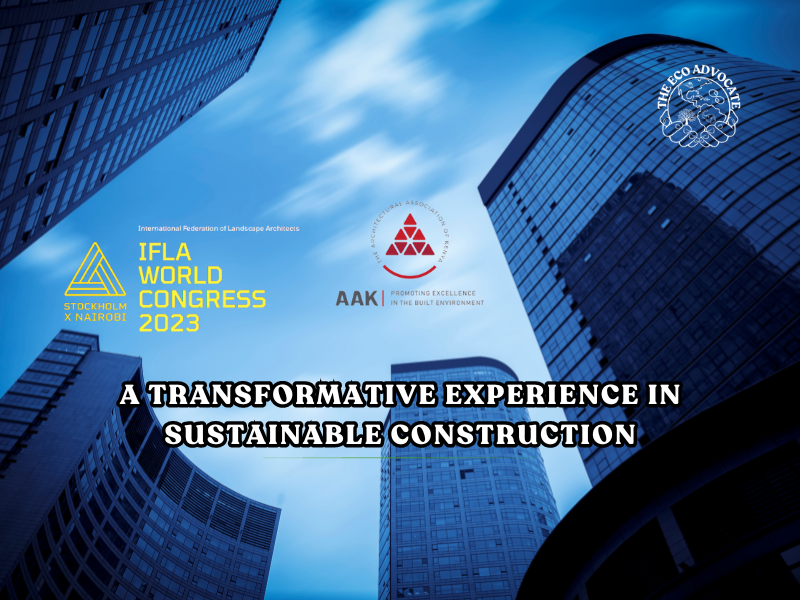Attending the Architectural Association of Kenya Convention was not just any event for me, but rather a significant milestone in my journey to understand how the construction industry can positively contribute to our environment. The convention shed light on crucial aspects of sustainable building practices. It emphasized the importance of constructing buildings that are both resilient to climate change and environmentally friendly, without contributing to harmful emissions.
What I Hoped to Learn
Attending the AAK Convention was an opportunity I couldn’t pass on, especially as I had three specific expectations in mind that I was excited to fulfil:
- Learning more about climate-smart solutions: I want to explore construction techniques and technologies that have minimal impact on our climate.
- How to curb climate change through construction: I aimed to explore how the construction industry can mitigate climate change instead of contributing to it.
- Get to know what companies in construction are working towards addressing climate change and how: I wanted to identify construction companies implementing eco-friendly practices and how they did it.
I must admit that in recent years, I have become sceptical about large conventions and conferences. Many of these events seem to be focused on marketing with little actual follow-up or concrete action taken afterward. Nevertheless, I held onto the hope that this convention would be different. I hoped that it would act as a catalyst for positive change in the industry, driven by a genuine commitment to Mother Nature.
The Missing Link
Collaboration and Expertise
One of the critical issues highlighted during the convention was the tendency, in Kenya and perhaps globally, to prioritize the roles of foremen, masons, and casual labourers over architects, planners, civil engineers, and other experts who are essential for a well-executed construction project. This imbalance often arises due to cost constraints and a lack of awareness about the significance of these professionals.
The consequence of this imbalance can be observed in the increasing number of poorly constructed buildings, many of which are sinking or structurally unsound. Corruption further compounds these problems, as unscrupulous individuals sign off on subpar construction projects to bypass regulations, endangering the lives of future occupants.
However, there was a glimmer of hope when the panellists at the convention candidly discussed their challenges and admitted to the conflicts that could arise between different professionals in the industry. Recognizing these issues is the first step towards fostering collaboration and understanding the vital roles each expert plays in their respective domains.
The Architectural Association of Kenya Campaigns
The AAK Convention sheds light on two significant campaigns by the Architectural Association of Kenya – “Uko na Mjengo” and “Mulika Mjengo.” Both campaigns provide valuable resources to tackle building-related issues. “Mulika Mjengo” is particularly noteworthy, as it enables individuals to report structural flaws that may be overlooked by authorities due to bribery or negligence. This initiative provides an opportunity for early intervention and the prevention of potential disasters.
The Tree Planting Dilemma
In recent years, it has become common for corporations to talk about their tree-planting endeavours, supporting the government’s goal of planting 15 billion trees. However, most of these initiatives fall short in terms of follow-through and consistency in caring for the trees. Growing trees to maturity requires significant care and attention over several years.
During this convention, I came across an organization that takes a more meaningful approach. The organization focuses on growing trees in schools with the ultimate aim of using timber for building classrooms. This initiative not only supports education but also has a positive impact on the environment.
Embracing Nature in Your Living Space
Attending the AAK Convention made me ponder over the eco-friendliness of our living spaces. Are we entirely dependent on technology for lighting and heating, or have we blended natural elements to create a sustainable environment? As we delve deeper into the world of construction and its interplay with climate change and safety, it’s essential to consider how our living spaces can become healthier and more environmentally sustainable.
To sum it up, the AAK Convention was a profound experience that reignited my hope in the potential for positive change within the construction industry. It emphasized the pressing need for collaboration among professionals and the significance of addressing climate change and safety concerns in construction. As we embark on this journey to explore these topics further, let’s bear in mind that our actions today will shape the future of our built environment and its impact on our planet.

